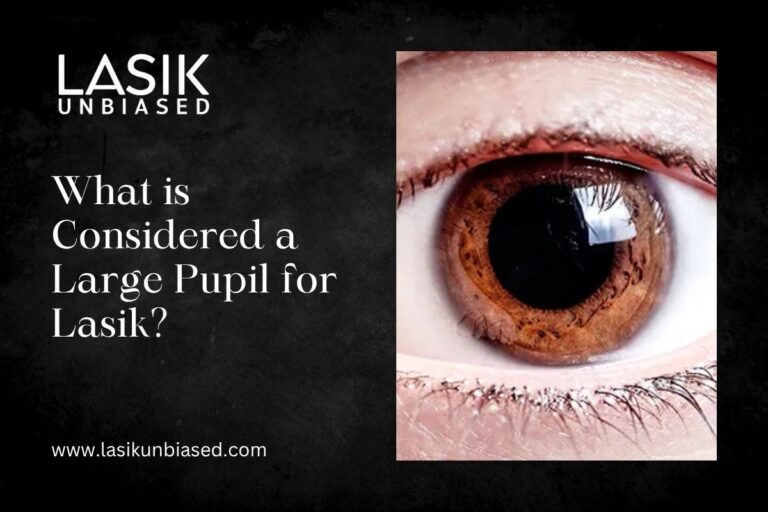A large pupil for LASIK is typically defined as a pupil that measures 7 millimetres or more in dim lighting conditions.
While having large pupils doesn’t automatically disqualify you from LASIK, it does require special consideration to minimise the risk of night vision issues like glare and halos.
If you’re considering LASIK, you’ve probably heard about the importance of pupil size. But what exactly qualifies as a “large” pupil, and why does it matter for laser eye surgery? This blog will answer those questions and help you understand how pupil size can impact your LASIK experience.
Why Pupil Size Matters in LASIK Surgery?
The pupil is the black, round opening at the centre of your iris that regulates the amount of light entering your eye. Its size changes based on lighting, emotions, age, and even certain medications. In bright light, pupils contract; in dim light, they dilate—sometimes reaching up to 7 or 8 millimetres in diameter.
For LASIK, the size of your pupil in low-light (scotopic) conditions is especially important. This is because if your pupils expand beyond the area corrected by the laser, you may experience visual disturbances, particularly at night.
Defining a “Large” Pupil for LASIK
Most surgeons and clinics consider a pupil size of 7 millimetres or more in dim light to be “large” for LASIK purposes. Here’s how it breaks down:
- Normal pupil size in bright light: 2–4 mm
- Normal pupil size in darkness: 4–8 mm
- Large pupil for LASIK: 7 mm or more in dim lighting
It’s worth noting that this threshold can vary slightly between clinics and surgeons, but 7 mm is the most commonly cited cutoff.
How Pupil Size is Measured for LASIK?
Ophthalmologists use a device called a pupillometer to measure your pupil size accurately under various lighting conditions. This ensures that your treatment plan matches your individual anatomy and minimises the risk of post-surgery issues.
Key factors that influence pupil size:
- Age (younger people tend to have larger pupils)
- Lighting conditions (pupils dilate in low light)
- Genetics
- Certain medications
Why Large Pupils Can Be a Concern for LASIK?
If your pupil dilates beyond the laser’s treatment zone, you may experience:
- Halos around lights
- Glare, especially at night
- Starbursts or ghost images
These symptoms are more likely if the optical zone (the area fully treated by the laser) is smaller than your maximum pupil size. For example, if your pupil expands to 8 mm in the dark but your optical zone is only 6.5 mm, light entering through the untreated peripheral cornea can cause visual disturbances.
Advances in LASIK Technology and Large Pupils
The good news: Modern LASIK lasers can treat larger optical zones—often up to 6.5 mm or more, with blend zones extending to 8 or 9 mm. This has greatly reduced the risk of night vision problems for patients with large pupils.
However, only the optical zone receives the full corrective treatment; the blend zone tapers the correction to reduce sharp transitions but doesn’t fully correct vision in that area.
Does Having Large Pupils Disqualify You from LASIK?
Not necessarily.
Having large pupils means your surgeon will pay extra attention to your measurements and may recommend advanced or customised LASIK techniques. In some cases, they may advise against LASIK if your risk of night vision problems is too high, but many patients with large pupils still achieve excellent results with today’s technology.
What Do Studies Say About Large Pupils and LASIK Outcomes?
- Older studies linked large pupils to higher rates of glare and halos after LASIK, especially when lasers treated smaller optical zones.
- Recent research shows that with modern, wavefront-guided LASIK and larger treatment zones, there’s no significant long-term difference in night vision symptoms between patients with large and average-sized pupils.
- Some studies even found that patients with medium-sized pupils had fewer night vision disturbances than those with small or large pupils, but the differences were minor and often resolved over time.
How to Know if Your Pupils Are Too Large for LASIK?
At your LASIK consultation, your pupil size will be accurately assessed under both well-lit and dim lighting conditions. If your pupils are 7 mm or larger in low light, your surgeon will discuss the potential risks and benefits with you. They may:
- Recommend a larger optical zone if your corneal thickness allows
- Suggest alternative procedures if the risk is too high
- Counsel you about the possibility of night vision symptoms
Tips for LASIK Candidates with Large Pupils
- Ask about your measured pupil size and how it compares to the planned optical zone
- Discuss the type of laser and treatment zone your surgeon will use
- Be honest about your night vision needs (e.g., if you drive at night often)
- Consider a second opinion if you’re unsure about your candidacy
Bottom Line
- A large pupil for LASIK is generally 7 mm or more in dim lighting.
- Large pupils can increase the risk of night vision disturbances if the optical zone is too small.
- Modern LASIK technology has made it possible to safely treat many patients with large pupils.
- Pupil size is just one factor in LASIK candidacy—your surgeon will consider your overall eye health, corneal thickness, and lifestyle needs.
If you’re considering LASIK and have concerns about your pupil size, schedule a consultation with an experienced surgeon. They can provide personalised advice and help you make the safest, most informed choice for your vision.
Ready to take the next step? Book a LASIK evaluation and let your surgeon know you want to discuss pupil size and night vision in detail. Your path to clearer vision starts with the right information.
Frequently Asked Questions
Is a 6.5 mm pupil considered large for LASIK?
A 6.5 mm pupil is at the upper end of average. Most surgeons consider 7 mm or more as “large,” but 6.5 mm may still require special planning.
Does pupil size affect LASIK results?
With modern technology, pupil size has less impact than it once did. However, large pupils can still increase the risk of night vision issues if not properly addressed.
Can I have LASIK if my pupils are 8 mm?
You may still be a candidate, but your surgeon will need to evaluate your corneal thickness and discuss the risks. Some clinics can treat larger pupils with customised approaches.
Are night vision problems permanent after LASIK?
Most night vision symptoms improve within 6–12 months after surgery, especially with modern techniques. Persistent problems are rare but possible.


